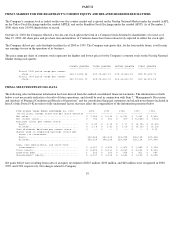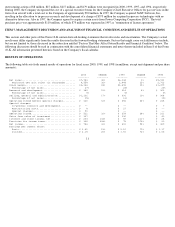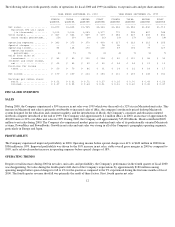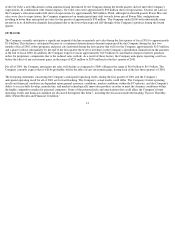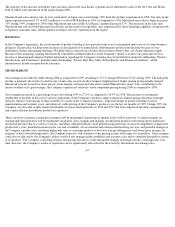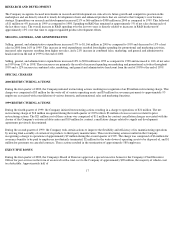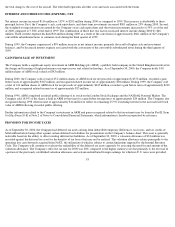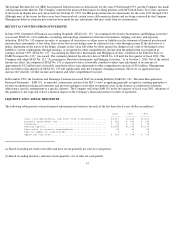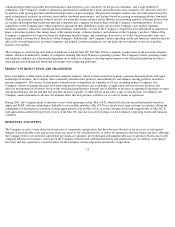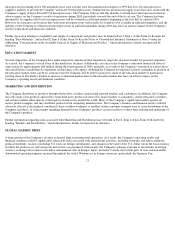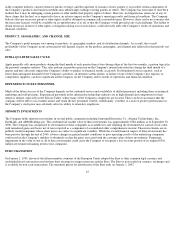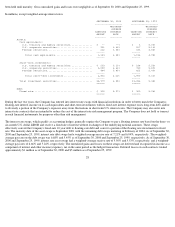Apple 2000 Annual Report Download - page 22
Download and view the complete annual report
Please find page 22 of the 2000 Apple annual report below. You can navigate through the pages in the report by either clicking on the pages listed below, or by using the keyword search tool below to find specific information within the annual report.
The Internal Revenue Service (IRS) has proposed federal income tax deficiencies for the years 1984 through 1991, and the Company has made
certain prepayments thereon. The Company contested the proposed deficiencies by filing petitions with the United States Tax Court, and most
of the issues in dispute have now been resolved. On June 30, 1997, the IRS proposed income tax adjustments for the years 1992 through 1994.
Although most of the issues for these years have been resolved, certain issues still remain in dispute and are being contested by the Company.
Management believes adequate provision has been made for any adjustments that may result from tax examinations.
RECENT ACCOUNTING PRONOUNCEMENTS
In June 1998, Statement of Financial Accounting Standards (SFAS) No. 133, "Accounting for Derivative Instruments and Hedging Activities"
was issued. SFAS No. 133 establishes accounting and reporting standards for derivative instruments, hedging activities, and exposure
definition. SFAS No. 133 requires an entity to recognize all derivatives as either assets or liabilities in the statement of financial position and
measure those instruments at fair value. Derivatives that are not hedges must be adjusted to fair value through income. If the derivative is a
hedge, depending on the nature of the hedge, changes in fair value will either be offset against the change in fair value of the hedged assets,
liabilities, or firm commitments through earnings, or recognized in other comprehensive income until the hedged item is recognized in
earnings. In June 1999, SFAS No. 137, "Accounting for Derivative Instruments and Hedging Activities--Deferral of the Effective Date of
FASB Statement No. 133," was issued. The statement deferred the effective date of SFAS No. 133 until the first quarter of fiscal 2001. The
Company will adopt SFAS No. 133, "Accounting for Derivative Instruments and Hedging Activities," as of October 1, 2000. Net of the related
income tax effect, the adoption of SFAS No. 133 is expected to have a favorable cumulative-effect-type adjustment to net income of
approximately $12 million and a favorable cumulative-effect-type adjustment to other comprehensive income of $15 million. Management
does not believe that adoption of SFAS No. 133 will significantly alter the Company's hedging strategies. However, its application may
increase the volatility of other income and expense and other comprehensive income.
In December 1999, the Securities and Exchange Commission issued Staff Accounting Bulletin (SAB) No. 101, "Revenue Recognition in
Financial Statements." SAB 101, as amended, summarizes certain of the SEC's views in applying generally accepted accounting principles to
revenue recognition in financial statements and provides guidance on revenue recognition issues in the absence of authoritative literature
addressing a specific arrangement or a specific industry. The Company will adopt SAB 101 in the first quarter of fiscal year 2001. Adoption of
this guidance is not expected to have a material impact on the Company's financial position or results of operations.
LIQUIDITY AND CAPITAL RESOURCES
The following table presents selected financial information and statistics for each of the last three fiscal years (dollars in millions):
(a) Based on ending net trade receivables and most recent quarterly net sales for each period.
(b) Based on ending inventory and most recent quarterly cost of sales for each period.
19
2000 1999 1998
-------- -------- --------
Cash, cash equivalents, and short-term investments.......... $4,027 $3,226 $2,300
Accounts receivable, net.................................... $ 953 $ 681 $ 955
Inventory................................................... $ 33 $ 20 $ 78
Working capital............................................. $3,494 $2,736 $2,178
Days sales in accounts receivable(a)........................ 46 46 56
Days of supply in inventory(b).............................. 2 2 6
Operating cash flow......................................... $ 826 $ 798 $ 775



